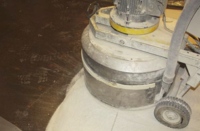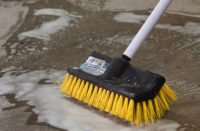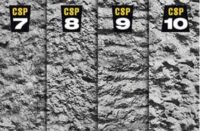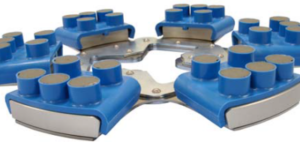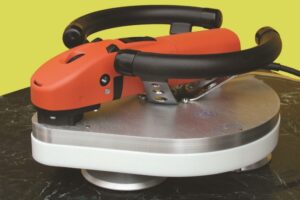One thing that the experts agree on when it comes to concrete surface preparation is that everybody has his own approach.
“It’s very subjective,” says Dennis Von Ruden, president of General Equipment Co. “There are no hard-core rules on how to approach surface prep.”
Surface prep, in its simplest form, is preparing the floor for decorative concrete. How you approach it is dependent on the planned type of installation.
Polishing and stain projects will get the least aggressive preparation or profile. Floors intended for epoxies, polyurethanes and overlays will be given a heavier profile. The thicker the material you are putting down, the heavier the profile of the surface prep must be, says Brad Padgett, CEO of Concrete Polishing Solutions. “Epoxies go down heavier than the urethanes, and overlays are typically thicker than the epoxies.”
Preparing the surface for polishing, he says, “is similar to what you’d be doing with any coatings in that you’d be removing any foreign materials, be it bond-breakers or surface imperfections, to prepare it for its final look or its final polish.”
Padgett recommends using the surface prep strategies presented by the International Concrete Repair Institute (ICRI). Along with industry guidelines, ICRI offers concrete-surface profile chips. These are rubber-molded, numbered samples that range from a number one to a number nine. Each number corresponds with a set of guidelines that state what that profile is, how to achieve it, and what coatings or overlays can be applied over it.
Epoxies and polyurethanes
When it comes to epoxies and polyurethanes, Chris Sullivan, vice president of sales and marketing for Chemsystems Inc., says that the two finishes are both high-performance coatings and require similar profiling to each other.
Within the ICRI guidelines, Sullivan adds, it is possible to get even more specific by looking at the viscosity and the solids content. “There is a difference between a 100-percent solids product and something that’s in the 50 to 60 percent solids range, in terms of profile,” he says.
ASTM Standards for Surface Prep
Also, there are at least four American Concrete Institute/ASTM standards that are relevant for surface prep.
- ASTM D4260-05: Standard Practice for Liquid and Gelled Acid Etching of Concrete
- ACI 503R-93: Use of Epoxy Compounds with Concrete
- ASTM D4262-83 (1999): Standard Test Method for pH of Chemically Cleaned or Etched Concrete Surfaces
- ASTM D4232-83 (2005): Standard Test Method for Indicating Moisture in Concrete by the Plastic Sheet Method
 Profiles are achieved by different methods. One is abrasive blasting, a category that includes sandblasting and shot-blasting, also known as blast-tracking. “(The blast-tracking process) literally hurls small steel balls at the surface to remove any loose area with minimal dust,” explains Bill Slama, senior technical advisor for Ceilcote, a product line of International Paint.
Profiles are achieved by different methods. One is abrasive blasting, a category that includes sandblasting and shot-blasting, also known as blast-tracking. “(The blast-tracking process) literally hurls small steel balls at the surface to remove any loose area with minimal dust,” explains Bill Slama, senior technical advisor for Ceilcote, a product line of International Paint.
Acid etching, using a 3-to-1 solution of hydrochloric acid, has long been a popular form for profiling the surface. But some are less inclined to use acid etching today, and the environmental impact of the acids is only one concern. “This method has its drawbacks, especially if the concrete had a coating or an oily surface that prevents the acid from reacting with the concrete surface,” says Slama. “It also isn’t used as much anymore because it is a wet treatment, and it has to be rinsed off very well, making it messy and the concrete too wet.”
Determining prep work
To determine what prep work needs to be done, the experts agree, the contractor should make a visual inspection of the concrete first to check out the overall condition of the surface.
You also use a water test. This involves spreading a thin layer of water on the concrete surface and timing how quickly water is absorbed. If the water absorbs within a few seconds, it indicates a porous surface, while longer absorption time means more in-depth surface prep is needed. Von Ruden says his trick to making sure the concrete is ready is to carry a jug of water with him as he uses a machine to prep the floor. “I slop a little water on the floor,” he says. “If I see the water is permeating the concrete and starting to dry, I’ll have a good bond. Everything is clean and the pores are open. If the water beads up, that’s a sign that something isn’t right and the job needs more work.”
Properly prepped concrete is free of contaminants and debris. It can be difficult to remove all the oil and grease from the surface, says Tim Slusher. Slusher is director of business development with Eagle Solutions. He recommends a mechanical scrubber with a brush and a light alkaline chemical to remove oils. “We use a scrubber with a brush that mechanically scrubs to agitate the surface,” he says.
Dust, on the other hand, is relatively easy to remove with vacuum systems.
Profiling problems
There are challenges in surface prep that need to be kept in mind. “The biggest ones are an overprofile and creating a profile pattern,” Sullivan says. “If you go too deep and then overprofile, you start to expose aggregate and jeopardize the decorative finish.”
Another challenge Sullivan encounters often is profile marks when surface prepping for staining or dying. “That means you leave either a track pattern or a sanding pattern, depending on the type of equipment being used.”
Moisture in the concrete is another challenge. The concrete needs to be as dry as possible. “Removing moisture is our Achilles heel,” says Padgett. “In the polishing process, the moisture in the slab isn’t nearly the issue as it would be in the coating process. Moisture inhibits the coating from getting a good bond.” Opening up the finish of the concrete can help the moisture travel to the surface faster and dissipate. Large fans can help dry the concrete.
Experts weigh-in
The experts agree that the approach to surface prep also depends on whether the job is new construction or rehab.
“When it is new construction, you can work with the architect,” Padgett explains. “He’s the one who has the vision on how everything should be brought together. You can make him understand that your prep is only as good as the floor the finishers give you. You can all work together to make sure everyone understands how they affect each other’s jobs.” But when it is a rehab job, Padgett says, “You’ve got what you’ve got. The concrete is already there, and whatever condition it is in is what you have to deal with.”
The important thing, he says, is to communicate with either the customer or the general contractor about the limits of surface prep methods. “You want to make sure the customer is well-educated on what the conditions of the floor is, what the end results could be and also other possible solutions.”
